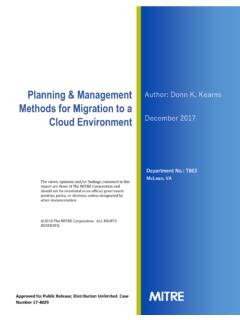Transcription of Guide to Intrusion Detection and Prevention Systems ... - NIST
1 Special Publication 800-94 Guide to Intrusion Detection and Prevention Systems (IDPS) Recommendations of the National Institute of Standards and Technology Karen Scarfone Peter Mell Guide to Intrusion Detection and Prevention Systems (IDPS) Recommendations of the National Institute of Standards and Technology Karen Scarfone Peter Mell NIST Special Publication 800-94 C O M P U T E R S E C U R I T YComputer Security Division Information Technology Laboratory National Institute of Standards and Technology Gaithersburg, MD 20899-8930 February 2007 Department of Commerce Carlos M. Gutierrez, Secretary Technology Administration Robert C. Cresanti, Under Secretary of Commerce for Technology National Institute of Standards and Technology William Jeffrey, Director Guide TO Intrusion Detection AND Prevention Systems (IDPS) Reports on Computer Systems Technology The Information Technology Laboratory (ITL) at the National Institute of Standards and Technology (NIST) promotes the economy and public welfare by providing technical leadership for the nation s measurement and standards infrastructure.
2 ITL develops tests, test methods, reference data, proof of concept implementations, and technical analysis to advance the development and productive use of information technology. ITL s responsibilities include the development of technical , physical, administrative, and management standards and guidelines for the cost-effective security and privacy of sensitive unclassified information in Federal computer Systems . This Special Publication 800-series reports on ITL s research, guidance, and outreach efforts in computer security and its collaborative activities with industry, government, and academic organizations. Certain commercial entities, equipment, or materials may be identified in this document in order to describe an experimental procedure or concept adequately. Such identification is not intended to imply recommendation or endorsement by the National Institute of Standards and Technology, nor is it intended to imply that the entities, materials, or equipment are necessarily the best available for the purpose.
3 National Institute of Standards and Technology Special Publication 800-94 Natl. Inst. Stand. Technol. Spec. Publ. 800-94, 127 pages (February 2007) iiiGUIDE TO Intrusion Detection AND Prevention Systems (IDPS) Acknowledgements The authors, Karen Scarfone and Peter Mell of the National Institute of Standards and Technology (NIST), wish to thank their colleagues who reviewed drafts of this document and contributed to its technical content. The authors would like to acknowledge John Connor, Tim Grance, Anoop Singhal, and Murugiah Souppaya of NIST; Michael Gerdes, Ralph Martins, Angela Orebaugh, and Mike Zeberlein of Booz Allen Hamilton; and Steve Sharma of Project Performance Corporation for their keen and insightful assistance throughout the development of the document. The authors particularly want to thank Rebecca Bace of KSR for her careful review of the publication and for her work on the predecessor publication, NIST Special Publication 800-31, Intrusion Detection Systems .
4 The authors would also like to express their thanks to security experts Andrew Balinsky (Cisco Systems ), Anton Chuvakin (LogLogic), Jay Ennis (Network Chemistry), John Jerrim (Lancope), and Kerry Long (Center for Intrusion Monitoring and Protection, Army Research Laboratory), as well as representatives from the Department of State and Gartner, for their particularly valuable comments and suggestions. Additional acknowledgements will be added to the final version of the publication. Trademarks All product names are registered trademarks or trademarks of their respective companies. ivGUIDE TO Intrusion Detection AND Prevention Systems (IDPS) Table of Contents Executive ES-1 1. Authority ..1-1 Purpose and Document 2. Intrusion Detection and Prevention Uses of IDPS Key Functions of IDPS Technologies ..2-2 Common Detection Signature-Based Anomaly-Based Stateful Protocol Types of IDPS Technologies.
5 2-6 3. IDPS Components and Typical Network Security Information Gathering Logging Detection Prevention Operation and Building and Maintaining 4. Network-Based Networking Application Transport Network Hardware Components and Typical Network Architectures and Sensor Security Information Gathering Logging Detection Prevention vGUIDE TO Intrusion Detection AND Prevention Systems (IDPS) Operation and 5. Wireless Wireless Networking WLAN WLAN Threats against Components and Typical Network Sensor Security Information Gathering Logging Detection Prevention Operation and 6. Network Behavior Analysis (NBA) System ..6-1 Components and Typical Network Sensor Security Information Gathering Logging Detection Prevention Operation and 7.
6 Host-Based Components and Typical Network Agent Host Security Logging Detection Prevention Other viGUIDE TO Intrusion Detection AND Prevention Systems (IDPS) 8. Using and Integrating Multiple IDPS Technologies ..8-1 The Need for Multiple IDPS Technologies ..8-1 Integrating Different IDPS Direct IDPS Indirect IDPS Integration ..8-3 Other Technologies with IDPS Network Forensic Analysis Tool (NFAT) Anti-Malware Firewalls and 9. IDPS Product General System and Network Goals and Security and Other IT External Resource Security Capability Information Gathering Logging Detection Prevention Performance Requirements ..9-6 Management Design and Implementation ..9-8 Operation and Training, Documentation, and technical Life Cycle Costs ..9-12 Evaluating Products.
7 9-13 IDPS Testing Challenges ..9-14 Recommendations for Performing IDPS List of Appendices Appendix A Glossary .. A-1 Appendix B B-1 Appendix C Tools and Resources .. C-1 Appendix D D-1 viiGUIDE TO Intrusion Detection AND Prevention Systems (IDPS) List of Figures Figure 4-1. TCP/IP Layers ..4-1 Figure 4-2. Inline Network-Based IDPS Sensor Architecture Figure 4-3. Passive Network-Based IDPS Sensor Architecture Figure 5-1. Wireless LAN Architecture Figure 5-2. Wireless IDPS Figure 6-1. NBA Sensor Architecture Figure 7-1. Host-Based IDPS Agent Deployment Architecture List of Tables Table 8-1. Comparison of IDPS Technology viiiGUIDE TO Intrusion Detection AND Prevention Systems (IDPS) Executive Summary Intrusion Detection is the process of monitoring the events occurring in a computer system or network and analyzing them for signs of possible incidents, which are violations or imminent threats of violation of computer security policies, acceptable use policies, or standard security practices.
8 Intrusion Prevention is the process of performing Intrusion Detection and attempting to stop detected possible incidents. Intrusion Detection and Prevention Systems (IDPS)1 are primarily focused on identifying possible incidents, logging information about them, attempting to stop them, and reporting them to security administrators. In addition, organizations use IDPSs for other purposes, such as identifying problems with security policies, documenting existing threats, and deterring individuals from violating security policies. IDPSs have become a necessary addition to the security infrastructure of nearly every organization. IDPSs typically record information related to observed events, notify security administrators of important observed events, and produce reports. Many IDPSs can also respond to a detected threat by attempting to prevent it from succeeding. They use several response techniques, which involve the IDPS stopping the attack itself, changing the security environment ( , reconfiguring a firewall), or changing the attack s content.
9 This publication describes the characteristics of IDPS technologies and provides recommendations for designing, implementing, configuring, securing, monitoring, and maintaining them. The types of IDPS technologies are differentiated primarily by the types of events that they monitor and the ways in which they are deployed. This publication discusses the following four types of IDPS technologies: Network-Based, which monitors network traffic for particular network segments or devices and analyzes the network and application protocol activity to identify suspicious activity Wireless, which monitors wireless network traffic and analyzes it to identify suspicious activity involving the wireless networking protocols themselves Network Behavior Analysis (NBA), which examines network traffic to identify threats that generate unusual traffic flows, such as distributed denial of service (DDoS) attacks, certain forms of malware, and policy violations ( , a client system providing network services to other Systems ) Host-Based, which monitors the characteristics of a single host and the events occurring within that host for suspicious activity.
10 Implementing the following recommendations should facilitate more efficient and effective Intrusion Detection and Prevention system use for Federal departments and agencies. Organizations should ensure that all IDPS components are secured appropriately. Securing IDPS components is very important because IDPSs are often targeted by attackers who want to prevent the IDPSs from detecting attacks or want to gain access to sensitive information in the IDPSs, such as host configurations and known vulnerabilities. IDPSs are composed of several types of components, including sensors or agents, management servers, database servers, user and administrator consoles, and management networks. All components operating Systems and applications should be kept fully up-to-date, and all software-based IDPS components should be hardened against threats. Specific 1 An Intrusion Detection system (IDS) is software that automates the Intrusion Detection process.













